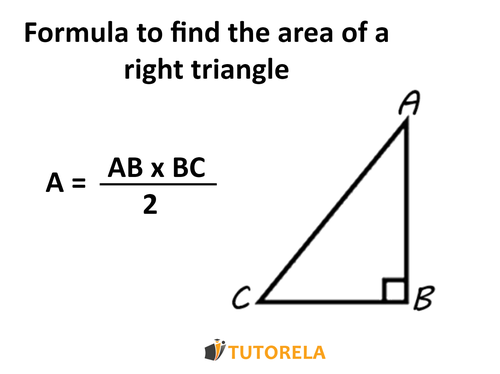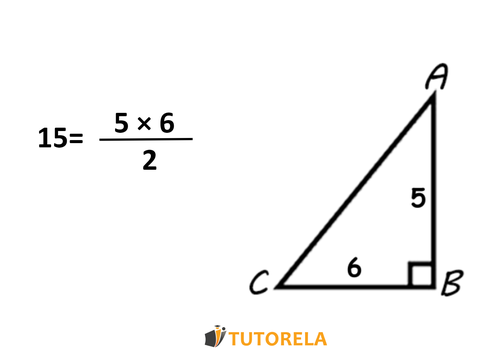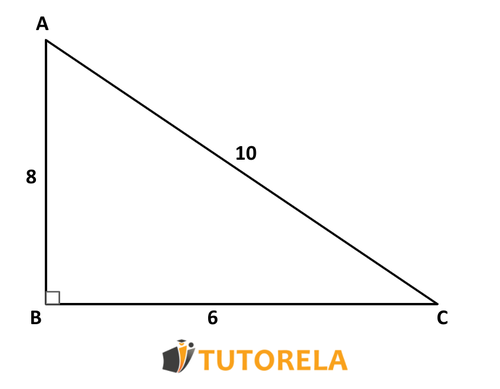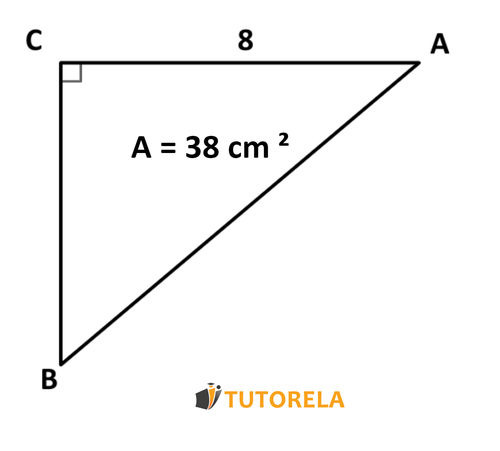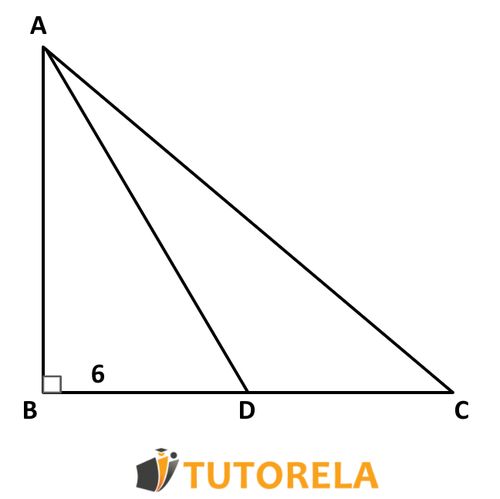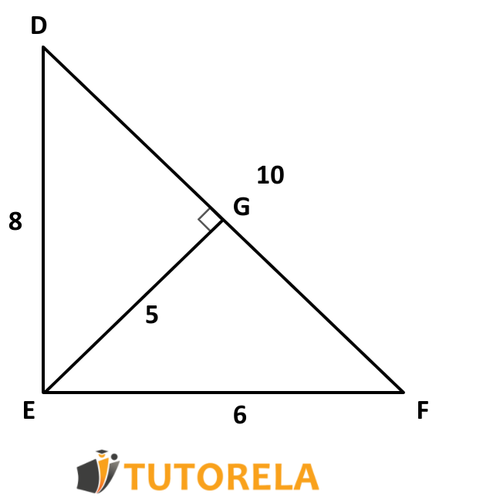Right triangle Exercise with explanation For example:
If we have a right triangle whose legs measure 5 c m 5~cm 5 c m 6 c m 6~cm 6 c m multiply 5 5 5 6 6 6 2 2 2
That is, the area of the given triangle is 15 c m 2 15~cm^2 15 c m 2
Join Over 30,000 Students Excelling in Math!
Endless Practice, Expert Guidance - Elevate Your Math Skills Today
Exercises to calculate the area of a right triangle Exercise 1 Homework:
In front of you is a right triangle, calculate its area.
Solution:
Calculate the area of the triangle using the formula for calculating the area of a right triangle.
l e g × l e g 2 \frac{leg\times leg}{2} 2 l e g × l e g
A B ⋅ B C 2 = 8 ⋅ 6 2 = 48 2 = 24 \frac{AB\cdot BC}{2}=\frac{8\cdot6}{2}=\frac{48}{2}=24 2 A B ⋅ BC = 2 8 ⋅ 6 = 2 48 = 24
Answer:
The answer is 24 c m 2 24~cm² 24 c m 2
Exercise 2 Homework:
Given the right triangle △ A D B \triangle ADB △ A D B
The perimeter of the triangle is equal to 30 cm 30\operatorname{cm} 30 cm
Given:
A B = 15 AB=15 A B = 15
A C = 13 AC=13 A C = 13
D C = 5 DC=5 D C = 5
C B = 4 CB=4 CB = 4
Homework:
Calculate the area of the triangle△ A B C \triangle~ABC △ A BC
Solution:
Given the perimeter of the triangle Δ A D C Δ~ADC Δ A D C 30 cm 30\operatorname{cm} 30 cm
From here we can calculate A D AD A D
A D + D C + A D = P e r i m e t e r Δ A D C AD+DC+AD=PerimeterΔ~ADC A D + D C + A D = P er im e t er Δ A D C
A D + 5 + 13 = 30 AD+5+13=30 A D + 5 + 13 = 30
A D + 18 = 30 AD+18=30 A D + 18 = 30 − 18 -18 − 18
A D = 12 AD=12 A D = 12
Now we can calculate the area of the triangle Δ A B C Δ~ABC Δ A BC
Pay attention: we are talking about an obtuse triangle therefore its height is A D AD A D
We use the formula to calculate the area of the triangle:
h e i g h t × s i d e 2 = \frac{height\times side}{2}= 2 h e i g h t × s i d e =
A D ⋅ B C 2 = 12 ⋅ 4 2 = 48 2 = 24 \frac{AD\cdot BC}{2}=\frac{12\cdot4}{2}=\frac{48}{2}=24 2 A D ⋅ BC = 2 12 ⋅ 4 = 2 48 = 24
Answer:
The area of the triangle Δ A B C ΔABC Δ A BC 24 c m 2 24~cm² 24 c m 2
Do you know what the answer is?
Question 2 a the legs and the hypotenuse
Exercise 3 Homework:
Given the right triangle Δ A B C Δ~ABC Δ A BC
The area of the triangle is equal to 38 c m 2 38~cm² 38 c m 2 A C = 8 AC=8 A C = 8
Find the measure of the leg B C BC BC
Solution:
We will calculate the length of B C BC BC using the formula for calculating the area of the right triangle:
l e g × l e g 2 \frac{leg\times leg}{2} 2 l e g × l e g
A C ⋅ B C 2 = 8 ⋅ B C 2 = 38 \frac{AC\cdot BC}{2}=\frac{8\cdot BC}{2}=38 2 A C ⋅ BC = 2 8 ⋅ BC = 38
We multiply the equation by the common denominator
/ × 2 \times2 × 2
Then we divide the equation by the coefficient of B C BC BC
8\timesBC=76 /: 8 :8 : 8
B C = 9.5 BC=9.5 BC = 9.5
Answer:
The length of the leg B C BC BC 9.5 9.5 9.5
Exercise 4
In front of you, there is a right triangle Δ A B C Δ~ABC Δ A BC
Given that B C = 6 BC=6 BC = 6 A B AB A B 33 1 3 % 33\frac{1}{3}\% 33 3 1 % B D BD B D
The area of the triangle △ A D C \triangle~ADC △ A D C 25 % 25\% 25% △ A B D \triangle~ABD △ A B D
Task:
What is the area of the triangle △ A B C \triangle~ABC △ A BC
Solution:
To find the measure of the leg A B AB A B 33.33 33.33 33.33 B D BD B D
A B = 1.33333 ⋅ B D AB=1.33333\cdot BD A B = 1.33333 ⋅ B D
( 100 100 + 33.33 100 = 133.33 100 = 1.333 ) (\frac{100}{100}+\frac{33.33}{100}=\frac{133.33}{100}=1.333) ( 100 100 + 100 33.33 = 100 133.33 = 1.333 )
A B = 1.333 ⋅ 6 = 8 AB=1.333\cdot6=8 A B = 1.333 ⋅ 6 = 8
Now we will calculate the area of the triangle Δ A B D ΔABD Δ A B D
A Δ ABD = A B ⋅ B D 2 = 8 ⋅ 6 2 = 48 2 = 24 A~Δ\text{ABD}=\frac{AB\cdot BD}{2}=\frac{8\cdot6}{2}=\frac{48}{2}=24 A Δ ABD = 2 A B ⋅ B D = 2 8 ⋅ 6 = 2 48 = 24
Answer:
24 c m 2 24~cm² 24 c m 2
Check your understanding
Question 3 b It cannot be calculated.
Exercise 5
Homework:
Which data in the graph is incorrect?
For the area of the triangle to be 24 c m 2 24~cm² 24 c m 2
Solution:
Explanation: area of the right triangle.
A Δ E D F = E D ⋅ E F 2 = 8 ⋅ 6 2 = 48 2 = 24 AΔEDF=\frac{ED\cdot EF}{2}=\frac{8\cdot6}{2}=\frac{48}{2}=24 A Δ E D F = 2 E D ⋅ EF = 2 8 ⋅ 6 = 2 48 = 24
According to the formula:
l e g × l e g 2 \frac{leg\times leg}{2} 2 l e g × l e g
If the area of the triangle can also be calculated from the formula of:
s i d e × s i d e h e i g h t 2 \frac{side\times side~height}{2} 2 s i d e × s i d e h e i g h t
E G × 10 2 = 24 \frac{EG\times10}{2}=24 2 EG × 10 = 24 × 2 \times2 × 2
10 E G = 48 10EG=48 10 EG = 48 : 10 :10 : 10
E G = 4.8 EG=4.8 EG = 4.8
Answer:
The incorrect data is E G EG EG
The length of E G EG EG 4.8 cm 4.8\operatorname{cm} 4.8 cm
If you are interested in learning more about other triangle topics, you can enter one of the following articles:
In the blog of Tutorela you will find a variety of articles about mathematics.
Do you think you will be able to solve it?
Examples with solutions for Area of a right triangle Exercise #1 Calculate the area of the right triangle below:
10 10 10 6 6 6 8 8 8 A A A C C C B B B
Video Solution Step-by-Step Solution Due to the fact that AB is perpendicular to BC and forms a 90-degree angle,
it can be argued that AB is the height of the triangle.
Hence we can calculate the area as follows:
A B × B C 2 = 8 × 6 2 = 48 2 = 24 \frac{AB\times BC}{2}=\frac{8\times6}{2}=\frac{48}{2}=24 2 A B × BC = 2 8 × 6 = 2 48 = 24
Answer Exercise #2 Calculate the area of the triangle ABC using the data in the figure.
12 12 12 8 8 8 9 9 9 A A A B B B C C C D D D
Video Solution Step-by-Step Solution First, let's remember the formula for the area of a triangle:
(the side * the height that descends to the side) /2
In the question, we have three pieces of data, but one of them is redundant!
We only have one height, the line that forms a 90-degree angle - AD,
The side to which the height descends is CB,
Therefore, we can use them in our calculation:
C B × A D 2 \frac{CB\times AD}{2} 2 CB × A D
8 × 9 2 = 72 2 = 36 \frac{8\times9}{2}=\frac{72}{2}=36 2 8 × 9 = 2 72 = 36
Answer Exercise #3 Calculate the area of the following triangle:
4 4 4 5 5 5 A A A B B B C C C E E E
Video Solution Step-by-Step Solution The formula for calculating the area of a triangle is:
(the side * the height from the side down to the base) /2
That is:
B C × A E 2 \frac{BC\times AE}{2} 2 BC × A E
We insert the existing data as shown below:
4 × 5 2 = 20 2 = 10 \frac{4\times5}{2}=\frac{20}{2}=10 2 4 × 5 = 2 20 = 10
Answer Exercise #4 Calculate the area of the following triangle:
6 6 6 7 7 7 A A A B B B C C C E E E
Video Solution Step-by-Step Solution The formula for the area of a triangle is
A = h ⋅ b a s e 2 A = \frac{h\cdot base}{2} A = 2 h ⋅ ba se
Let's insert the available data into the formula:
(7*6)/2 =
42/2 =
21
Answer Exercise #5 Calculate the area of the triangle below, if possible.
8.5 8.5 8.5 7 7 7
Video Solution Step-by-Step Solution The formula to calculate the area of a triangle is:
(side * height corresponding to the side) / 2
Note that in the triangle provided to us, we have the length of the side but not the height.
That is, we do not have enough data to perform the calculation.
Answer 